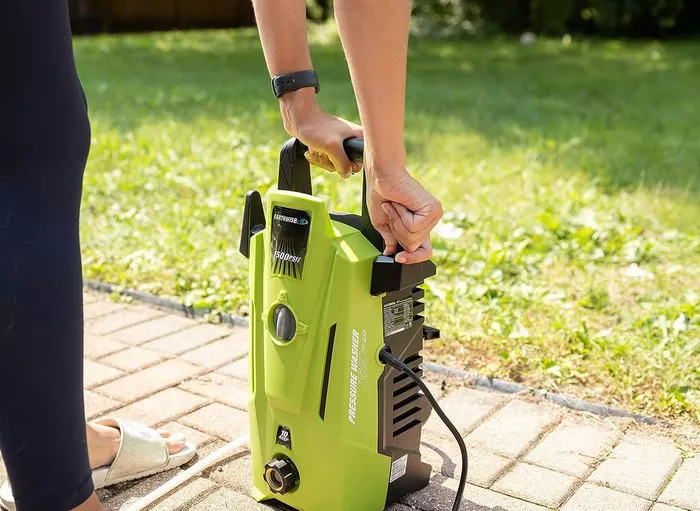Selecting the appropriate pressure washer for your cleaning tasks is crucial for achieving optimal results. Consider factors such as home size, floor type, and whether you have pets to determine the most suitable model.
For smaller homes or light cleaning tasks, a lower PSI (pounds per square inch) and GPM (gallons per minute) rating may suffice. However, for larger homes or tougher cleaning jobs, opt for a higher PSI and GPM for more power.
Preparation is Key
Before using a pressure washer, it’s essential to prepare the area to be cleaned. Remove any obstacles, such as furniture or toys, and cover delicate plants or objects that could be damaged by the high-pressure water.
Inspect the area for loose debris or obstacles that could interfere with the cleaning process. Clearing these beforehand will ensure a smoother and more effective cleaning experience.
Adjusting Settings for Different Surfaces
Different surfaces require different pressure settings to avoid damage. Adjust the pressure washer’s settings based on the surface being cleaned:
1. Hard Surfaces (e.g., concrete, brick): Use higher pressure settings to remove stubborn dirt and stains effectively.
2. Soft Surfaces (e.g., wood, siding): Lower the pressure to prevent damage to the surface while still achieving a thorough clean.
3. Delicate Surfaces (e.g., glass, vehicles): Use the lowest pressure setting and appropriate attachments to avoid scratching or etching.
Understanding Attachments
Pressure washers often come with various attachments designed for specific cleaning tasks. Here’s a brief overview of common attachments and their uses:
1. Rotary Nozzle: Provides a rotating spray pattern for increased cleaning power, ideal for removing tough stains on hard surfaces.
2. Surface Cleaner: Attaches to the pressure washer and provides a consistent, even cleaning path, perfect for large flat surfaces like driveways and patios.
3. Soap Nozzle: Dispenses detergent for deep cleaning and stain removal.
4. Turbo Nozzle: Combines the force of a 0-degree nozzle with the coverage of a 25-degree nozzle, offering increased cleaning power for stubborn stains.
Choose the appropriate attachment based on the specific cleaning situation to maximize efficiency and effectiveness.
Paying Attention to Cleaning Details
To ensure comprehensive cleaning and avoid duplication of work, plan your cleaning process and pay attention to details. Start from the highest point and work your way down to prevent dirt and debris from falling onto previously cleaned areas.
Divide the cleaning area into manageable sections and tackle one at a time. This approach helps maintain focus and ensures that no areas are overlooked.
Regular Maintenance for Optimal Performance
Proper maintenance is essential to keep your pressure washer performing at its best. Follow these maintenance suggestions:
1. Regularly replace worn or damaged parts: Inspect hoses, nozzles, and seals for wear and tear, and replace them as needed to prevent leaks and maintain optimal performance.
2. Clean the pressure washer after each use: Remove any debris or detergent residue to prevent clogs and corrosion.
3. Inspect power cords and connections: Check for fraying or damage and repair or replace as necessary to ensure safe operation.
By following these maintenance suggestions, you can prolong the life of your pressure washer and ensure consistent performance.
FAQs
Q1: Can I use a pressure washer indoors?
A1: It’s not recommended to use a pressure washer indoors due to the potential for water damage and safety hazards. However, if necessary, ensure proper ventilation and use a low-pressure setting.
Q2: How often should I clean my pressure washer?
A2: Clean your pressure washer after each use to prevent buildup of dirt and debris. Additionally, perform a thorough cleaning and maintenance check periodically, especially if it’s been stored for an extended period.
Q3: Can I use bleach or other chemicals with my pressure washer?
A3: Yes, many pressure washers are compatible with detergents and cleaning chemicals. However, always follow the manufacturer’s recommendations and dilution instructions to avoid damaging the equipment or surfaces being cleaned.
Conclusion
In conclusion, using a pressure washer effectively involves selecting the right model, preparing the area, adjusting settings based on surface type, understanding attachments, paying attention to details, and performing regular maintenance. By following these guidelines and tips, you can achieve optimal cleaning results and prolong the life of your pressure washer.

